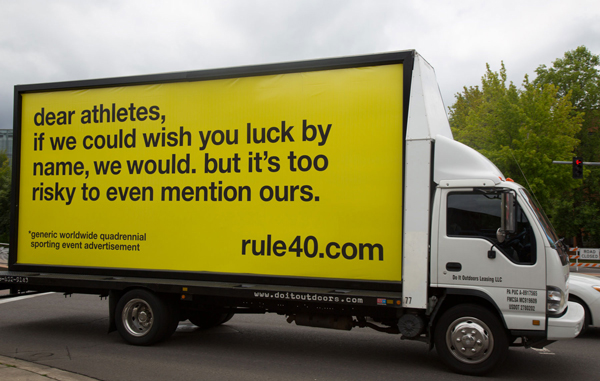Olympic Marketing: Rule 40’s Herculean Undertaking
While I shoveled nostalgic coal into the roaring engine of my Olympic hype train this weekend, something caught my eye. I expected predictions of the impending contests, but I didn’t anticipate such a hotly contested gauntlet in marketing at the Olympics.
We’ve seen the World Health Organization, governments and scientists declare war on the Zika virus. Read harrowing studies of the bacterial soup athletes and spectators will encounter. Heard Eduardo Paes, Mayor of Rio de Janeiro, bombastically offer a kangaroo to ease Australian athletes’ safety concerns.
These concerns have had – and should continue to occupy – the full attention of organizers, participants and attendees. A different controversy is taking hold of companies focused on the patriotic eyeballs of those firmly planted on a couch, bar stool or even computer chair – if a mid-day event just happens to appear within a cubicle browser.
Rule 40’s Unexpected Marketing Consequences
The International Olympic Committee (IOC) and U.S. Olympic Committee (USOC) seemed to peel back a layer of the restrictions on marketing around the Olympics last year, but Rule 40 still hampers athletes’ ability to profit from their images and, perhaps more costly, social media accounts between July 27-August 24.
The IOC and USOC handed athletes with smaller sponsors (read: New Balance, Saucony) a straw to fill Michael Phelps’ 50-meter habitat for viewer attention, while opening the floodgates for mega Olympic sponsors (Nike, McDonald’s).
Now, to be fair, I do understand the need to preserve and reinforce the value of the $25 million per year price ticket for top global sponsors, with aspirations to double these fees by 2021, as reported by Reuters. But it has unleashed a flurry of smart marketing from brands like Under Armour – who was surprisingly lumped into an article about startups and Rule 40 by Inc. – including my favorite ad of the year (likely last several years):
This spot launched in March and doesn’t include any prohibited trademarks, yet it delivered a gut punch to premium sponsors.
Elsewhere, Brooks Running Co. “secretly” launched an ambush marketing campaign around the Rio games, according to the Wall Street Journal, although I’m not sure how clandestine it could hope to be if the WSJ was able to find the source via a simple domain registry. The campaign, “Rule 40,” was spotted in protest around some of the U.S. trials, including the U.S. Olympic track-and-field trials in July, where a flatbed billboard truck circled the grounds.
Who will take home Marketing Gold?
Brands that paid the premium will undoubtedly capitalize on the primetime slots. We know that Morgan Freeman’s satin voice will envelope sentimental memories, and seal it with a Visa slogan. We expect to see a beaming child at a McDonald’s to dig into two all-beef patties, special sauce… well, you know the rest.
But what we don’t know is which creative upstart will elude the restrictions and somersault over the established, resource-rich brands.
So in the spirit of the Olympic games, I’ll say to marketers everywhere, instead of “Faster, Higher, Stronger,” aim for smarter and sharper. You may just pull off an upset.
Leave a comment below letting me know your thoughts on Rule 40, or your favorite Olympic memory.




Leave a comment:
You must be logged in to post a comment.